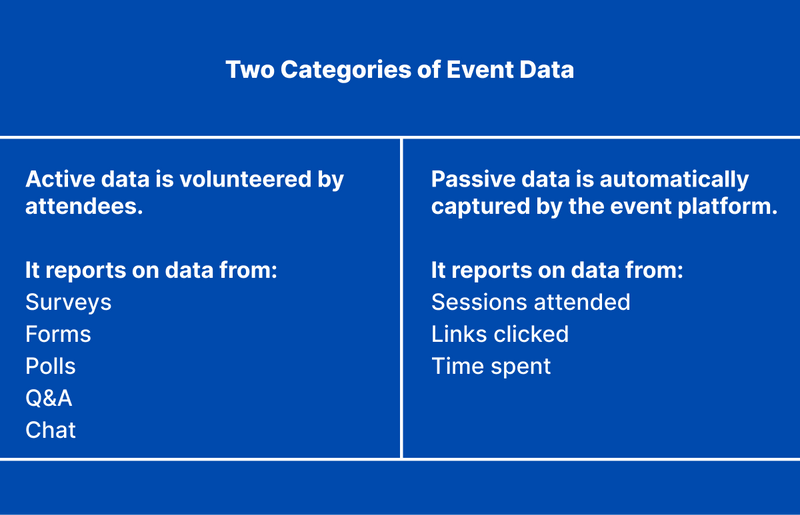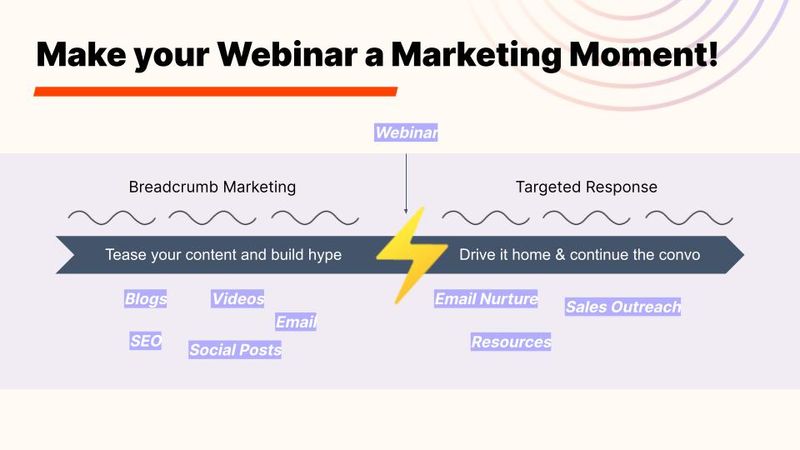10 High-Impact Ways to Use Your Event Data

Maximize Your Marketing ROI
Join 10,000 other marketers already getting the best tips on running engaging events that boost pipeline and create raving fans.
Marketers are no longer thought of as the people who "just make things pretty." These days, almost every marketing role is deeply rooted in data.
Event marketers are no exception. If your focus is on virtual or hybrid events, modern event technology gives you more than enough data to optimize your events and smash your goals.
The trick is knowing how to use it. (And of course, it still doesn’t hurt to make things pretty.)
Solid data can take your event strategy to a whole new level. Expertly wielding event data empowers you to create incredible attendee experiences, prove event ROI, and pass more opportunities to sales. Read on to learn 10 high-impact ways to use your event data.
10 ways to use event data
- Make real-time adjustments to your event
- Improve event logistics
- Identify your most engaged accounts
- Personalize your follow-ups
- Improve future event content
- Drive net new pipeline
- Measure event ROI
- Improve customer retention rates
- Inform future marketing campaigns
- A/B test message formats and delivery
But first: Understanding active vs. passive event data
With modern virtual event platforms, you can collect a lot of data. As mentioned, the magic is in how you use it. Collected data falls into two categories, active and passive.
Active data is volunteered by attendees. It's information your attendee actively shares with you through interactive features like surveys, forms, polls, Q&A, chat, and 1:1s.
Active data can be either quantitative or qualitative, and since you're essentially asking attendees for it, you have the opportunity to customize your questions to gain exactly the information you want to know.
Passive data, on the other hand, is collected passively on the backend without attendee engagement. The user shares this information with you by simply attending and interacting with your event.

Passive data tends to be qualitative, coming in the form of analytics like sessions attended, links clicked, and time spent.
Both types of data are helpful in their own ways, and the best event data analysis strategies combine both to piece together a holistic picture of your audience's behavior and preferences.
Want a more in-depth look into the types of data that can be collected through events? Then check out our Maximizing Event ROI with Digital Engagement Data webinar, which is part of our Event ROI Bootcamp series.
10 powerful ways to use your event data
At Goldcast, we’re big believers in the power of using event data to build stronger brand experiences. We’ve worked with brands like ThoughtSpot, Salesloft, and Drift to help them connect with their audiences, generate demand, and drive pipeline—all of which requires a laser focus on data.
Here are our top 10 ways to use event data for maximum impact.
1. Make real-time adjustments to your event
You don't have to wait until your event is over to put the data you're collecting to work. If you're running a large, high-stakes event, you'll want to keep a pulse on the attendee experience to identify any adjustments in real-time.
For example, let’s say your event data shows that your networking sessions are blowing everything else out of the water in terms of attendance and engagement. Can you add a bonus networking session to your agenda, or up the sessions' memorability factor by incorporating a giveaway on the fly?
2. Improve event logistics
You know your event logistics are on point when... your attendees don't even notice your event logistics. A smooth attendee experience is everything, and unfortunately, even a tiny logistical glitch can be glaring to attendees.
You can analyze attendee behavior and feedback to improve logistical aspects like the registration process, session capacities, and resource allocation. For example, maybe your registration rate was particularly low for an event. You can look at the data to determine where folks dropped off—did the registration form ask for too much info? Or perhaps you allocated lots of resources and capacity to a session you thought would crush it, but only a handful of attendees showed up. Now you know for next time.
If logistics are a concern, choosing the right event platform is half the battle. Ashleigh Frank, a Goldcast customer and marketer at Cognism, explains: "After so many issues with our previous webinar platform, we wanted to make sure the next one would be seamless for us to use and easy for other people to learn too."
After switching to Goldcast, Ashleigh and her team were able to slash their time spent on tech checks and fighting fires, and focus on the parts of events that actually move the needle.
3. Identify your most engaged accounts
Highly-engaged accounts are worth their theoretical weight in gold. 🪙
When an attendee has shown high engagement during your event, you need to know ASAP so you can turn that engagement into a productive conversation.
Use virtual event data to identify attendees who join multiple sessions or interact with exhibitors—they may very well be your next MQL.
Candace Gregg, senior director of global demand gen at Bloomreach, uses Goldcast's integrations with Salesforce and Hubspot to track these high-priority accounts. "We just take our campaigns, sync them to Goldcast and Salesforce, and update all campaign statuses through workflows in Hubspot," Candace says.
In a matter of minutes, both the sales and marketing teams can see who registered, attended live, and attended on-demand. Each account has a clear engagement score so BDRs know who to follow up with first—and with Goldcast’s Slack integration, getting this info to sales in real-time has never been easier.

4. Personalize your follow-ups
Your attendees are literally telling you what they're interested in—all you have to do is pay attention to their behavior. With deep account-level insights at your fingertips, it would be a real shame to send all your attendees the same "thanks for coming" email.
Instead, use behavioral data to personalize follow-up communications, such as sending targeted emails to attendees who attended specific sessions or interacted with certain exhibitors.
At Zuora, a leading subscription and monetization platform, this personalization is key to post-event follow-ups.
"Our teams can look at a report and come armed to the conversation with, 'Hey, I saw you engaged in this way,'" says Hayley Ferrante, head of global demand program strategy. "Documents downloaded, poll and survey responses, hand-raisers and Q&A allow field marketers to understand what prospects are wanting to learn about and be that resource for them."
5. Improve future event content
Event data can help you improve your events both in real-time and in the future. 🔮
It's a no-brainer to see how your content performed and tweak it for next time. But are you diving deep, or are you stuck with basic analytics like attendance per session?
How about cohort data—for example, which specific company an attendee represents, their title, which sessions they attended—to identify which sessions attracted your ICP? After all, a session might have big attendance numbers, but if most of those folks were in roles other than decision-maker for your offer, there's no reason to cater to them.
First, identify the specific attendees who match your ICP (in Goldcast, you can find company and title info in the Attendee Summary of your Event Summary Report).
Then, analyze how those users interacted with your content:
- How long did they spend in each session?
- How did they respond to polls?
- What questions did they ask in Q&A?
- What types of sessions had the most engagement?
- Which sessions should you repeat vs. retire?
By digging into these detailed analytics, you can tailor future event content to these folks rather than your entire attendee base. It’s all about doing more of what impacts your bottom line, and less of what doesn't.

6. Drive net new pipeline
In the end, event and field marketers want to create pipeline and generate revenue. Event data is a great place to start by identifying those opportunities, whether they're new prospects or potential expansions.
Use your virtual event data to identify these leads by tracking attendee behavior, such as those who visited your booth or attended a session related to your product or service.
Then, for the love of revenue, align with the sales team on how to act on that information.
What kind of impact are we talking about here? How does $6.1 million in pipeline sound? The team at Benchling runs three or four webinars per quarter with the goal of driving product demos.
One quarterly webinar called What's New has generated a 30% return in users and an increase in customer upsells—all by simply sharing the latest product updates and releases.
Overall, the Benchling team has increased event attendance by 34% and generated $6.1 million in pipeline, making events a top three channel for account engagement.
7. Measure event ROI
An event marketer's quest to prove ROI is never complete. Luckily, tracking the right event data can put some serious power behind your ROI calculations.
Tracking metrics like registrations, engagement, conversions, and revenue generated can help you measure the direct ROI of your events and the influenced ROI.
Why is ROI important? As much as we know events can directly impact revenue goals, it's on you to prove it to your executive team.
"We look at last-touch but we also look at multi-touch attribution,” explains Laura Wille, director of customer marketing at Clari.
"If we look at our entire pipeline, every single opportunity is touched by some sort of virtual event or webinar.
Not only are we able to directly convert leads to qualified pipeline from our event program, we're also able to influence opportunities that are already open and help them progress through the funnel and influence closed-won revenue at the end."Laura Wille, Director of Customer Marketing at Clari.
Plus, there's another group that's keen to know the ROI of your events: sponsors and partners. Having clear data in this area can help you attract better sponsors and raise the bar on event quality over time.
Plus, there's another group that's keen to know the ROI of your events: sponsors and partners. Having clear data in this area can help you attract better sponsors and raise the bar on event quality over time.
8. Identify risk factors for churn and improve retention rates
If you're a customer marketer using events, retention is on your mind all day, every day. Use your event data to identify patterns and behaviors that indicate potential churn risks.
For example, which accounts didn't engage as much with your event? Which didn't attend at all? Did you receive any poor feedback from the event survey, whether about the actual event or your product? By themselves, these aren't necessarily indicators of an at-risk account, but they could still be worth digging into.
By proactively addressing these markers through targeted retention strategies and personalized offers, you can prevent some of that churn and increase customer satisfaction.
Here are some of our favorite events to help customer marketers boost retention:
- User conferences
- Product launch events
- Customer advisory boards
- User community events
9. Inform future marketing campaigns
Now that you've identified who was the most engaged with key elements of your event, don't sleep on digging up additional insights on that group. Their demographics, preferences, and behaviors can help you nail future marketing campaigns by:
- Refining buyer personas
- Segmenting your audience
- Personalizing campaign messaging
- Identifying the features customers are most excited about

10. A/B testing message formats and delivery
A virtual event is a controlled environment where you can test a variety of messaging strategies with your target audience.
In other words, it's an excellent A/B testing opportunity. 📈
By tracking metrics like email open rates, conversions, and engagement by cohort, you can determine which formats and delivery timing resonate the most with your key audiences. Then apply those learnings to other channels in your marketing mix.

Lean in to event data and watch your ROI soar
By collecting and analyzing the right data, you can improve your attendee experience, build more pipeline, and watch your event ROI continue to rise.
We hope these 10 ideas have your wheels turning on how you can be even more intentional in the data department.
Is your virtual event platform holding you back when it comes to collecting—and acting on—your data? As a revenue-driven event marketing platform, empowering you to harness your data is our focus at Goldcast. Let us empower your team with more data that can drive pipeline.

Transform Your Video Marketing with AI
Stay In Touch
Platform
Resources
© 2025 Copyright Goldcast, Inc. All rights reserved.





 Upcoming Events
Upcoming Events Event Series
Event Series On-Demand Events
On-Demand Events

